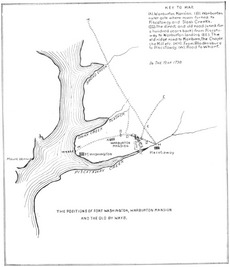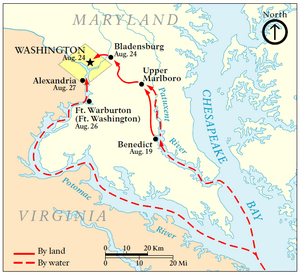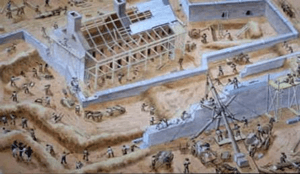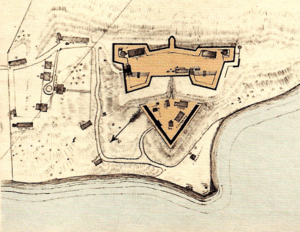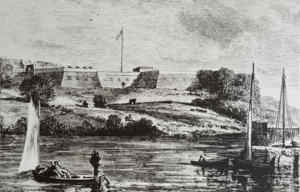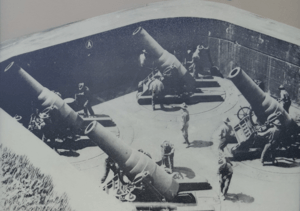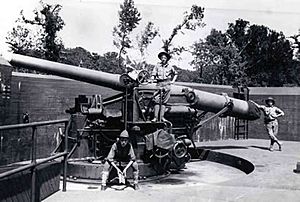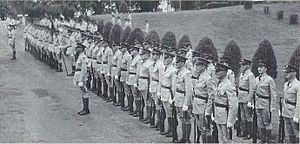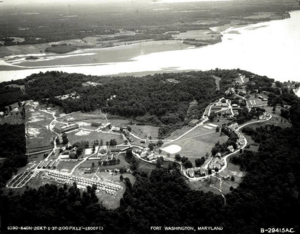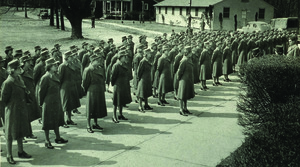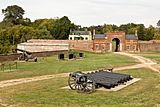Fort Washington Park facts for kids
Quick facts for kids Fort Washington Park |
|
|---|---|
|
IUCN Category III (Natural Monument)
|
|

Cannon outside Fort Washington, Maryland
|
|
| Location | Prince George's County, Maryland, U.S. |
| Nearest city | Fort Washington, Maryland, U.S. |
| Area | 341 acres (138 ha) |
| Visitors | 406,917 (in 2022) |
| Governing body | National Park Service |
| Website | Fort Washington Park |
|
Fort Washington
|
|
| Nearest city | Fort Washington, Maryland |
| Area | 341 acres (138 ha) |
| Built | 1808 |
| Built by | T.W. Maurice under Walker Keith Armistead |
| Architectural style | Second & Third Period |
| NRHP reference No. | 66000965 |
| Added to NRHP | October 15, 1966 |
Fort Washington is a historic fort located near Fort Washington, Maryland. For many years, it was the only fort protecting Washington, D.C. The fort sits high above the Potomac River, offering a great view.
The first fort was finished in 1809. It was first called Fort Warburton but got its new name in 1808. During the War of 1812, soldiers had to destroy the fort themselves. This happened when British forces were getting close.
The fort you see today was built starting in 1824. It is made of stone and has cannons that could fire far down the Potomac River. The fort was updated many times, especially in the 1840s and 1890s. In 1946, the fort became part of the U.S. Department of the Interior.
Today, the area is known as Fort Washington Park. It has trails for hiking and biking, and beautiful views of the river. It's a great place for picnics, fishing, and other outdoor fun. Sometimes, people dress up in old uniforms and act out historical events at the fort. There is also a small museum to explore.
The Fort Washington Light, a lighthouse, stands below the fort. It was first built in 1857. The current lighthouse tower is 28 feet tall and was built in 1882.
Contents
Fort Washington's Early History
Native Americans and First Settlements
Long ago, Native Americans lived where Piscataway Creek meets the Potomac River. They knew this spot was good for defense. In 1634, Governor Leonard Calvert explored the area. He saw about 500 Native Americans ready to defend their land.
Later, in 1661, Edward Digges started a large property called the Manor of Warburton here. It covered 1200 acres. George Washington, who lived across the river at Mount Vernon, often visited the Digges family. He saw how important this location was for protecting the river.
Building the First Fort
In 1794, President Washington asked for a fort to be built at this spot. But the money was used elsewhere. In 1805, the government finally decided to build a fort. Captain George Bomford led the project.
Work on the first fort began on April 14, 1808. It was finished on December 1, 1809. The fort was designed to hold 120 soldiers and 15 cannons. It was the only fort on the Potomac River at that time.
War of 1812 and the Fort's Destruction
British Advance on Washington
In 1812, the U.S. declared war on Great Britain. At first, there wasn't much fighting near Washington. But in 1814, British forces were free to focus on America.
In August 1814, a British fleet sailed up the Potomac River. The U.S. Secretary of War, General John Armstrong, Jr., thought the British were heading to Baltimore, not Washington. So, Washington's defenses were not ready.
Why the Fort Was Blown Up
On August 24, 1814, the British defeated American forces at Bladensburg. They then captured Washington, D.C. The commander of Fort Washington, Captain Samuel T. Dyson, was ordered to destroy the fort if the enemy got behind it.
On August 27, the British fleet approached Fort Washington. The fort had 26 cannons, but only nine could fire downriver. Captain Dyson and his 56 men decided to retreat. To prevent the British from using the fort's weapons, they blew it up.
The next morning, the British fleet finished destroying the fort. They then sailed upriver to capture Alexandria. Captain Dyson was later found guilty of abandoning his post and destroying government property. He was removed from the army.
Rebuilding and Civil War Role
A New Fort Rises
Less than a month after its destruction, Fort Washington began to be rebuilt. James Monroe, the acting Secretary of War, oversaw the project. The new fort was designed by Lt. Col. Walker Keith Armistead.
Construction of the new brick fort continued steadily. It was declared finished on October 2, 1824. The new fort cost $426,000. In the 1840s, the fort was greatly improved. Workers added 88 gun platforms and made the walls taller.
Fort Washington During the Civil War
As the country moved closer to the American Civil War, Fort Washington became very important. It was near the nation's capital and controlled movement on the Potomac River. Maryland was a slave state, but it stayed with the Union.
In January 1861, soldiers were sent to Fort Washington to protect it. Captain Joseph A. Haskin commanded the fort. For a while, Fort Washington was the only defense for Washington, D.C.
Later, many other forts were built around Washington. By the end of the war, 68 forts and batteries protected the city. Fort Washington did not see any direct fighting during the Civil War. The Confederate Navy never tried to attack the city from the Potomac.
Modernizing and World Wars
New Defenses for a New Era
After the Civil War, the U.S. realized its coastal defenses needed updating. New ships had powerful guns. In 1887, a group of engineers suggested a new system of defenses. This plan included heavy steel guns, large mortars, and underwater mines.
Work on these new defenses began in 1889. Most of the new defenses for Washington were built at Fort Washington. This included an underground room for firing electrically controlled mines.
New gun batteries were built, like Battery Decatur, named after naval hero Stephen Decatur. Other batteries included Emory, Humphreys, and Meigs. These new guns were designed to stop enemy ships from reaching Washington, D.C.
Spanish-American War and World War I
In April 1898, the Spanish–American War began. Work on the coastal defenses sped up. Mines were placed in the Potomac River for the first and only time.
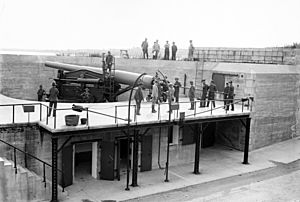
During World War I, some of Fort Washington's guns were removed and sent to Europe. The fort was used to train soldiers. Many military units were formed there. After the war, by 1929, Fort Washington was no longer an active defense post.
Between Wars and World War II
In 1930, Fort Washington Park was created by Congress. However, the fort remained under military control until 1939. During these years, soldiers from the 12th Infantry Regiment lived at the fort. They took part in parades and ceremonies in Washington.
In 1939, the fort was given to the United States Department of the Interior. A camp for the Civilian Conservation Corps was built there.
Fort Washington in World War II
After the Attack on Pearl Harbor in December 1941, the U.S. entered World War II. Fort Washington was returned to the War Department. It was used to train military personnel.
The Adjutant General School moved to the fort in 1942. It trained Army officers in administration. The school trained hundreds of officers every few months.
In 1943, the 67th WAAC Detachment arrived. These women took on administrative and communication jobs. This freed up men to fight overseas. They worked long hours but also had time for fun, like swimming and dances.
After the war, in 1946, the fort went back to the Department of the Interior. Many old buildings were removed. Since then, it has been a public park. It helps us remember the history of coastal forts and offers a place for outdoor activities.
Visiting Fort Washington Park Today
The visitor center is in a yellow house on the hill. It has exhibits about Fort Washington's role in protecting the capital. You can also watch a video about the fort.
There is a 3-mile trail around the park. Many people enjoy birdwatching here. You can also go fishing along the Potomac River.
Fort Washington Park is open all year. The park grounds are open from 8 AM to sunset. The historic fort and visitor center are open from 9 AM to 4 PM in winter and 9 AM to 5 PM in summer. Please remember that alcohol is not allowed in the park. Dogs are welcome but must be on a 6-foot leash.
On one Sunday each month, from April to October, the park hosts Civil War artillery demonstrations. These shows bring history to life!
- Photos of Fort Washington, MD
See also




